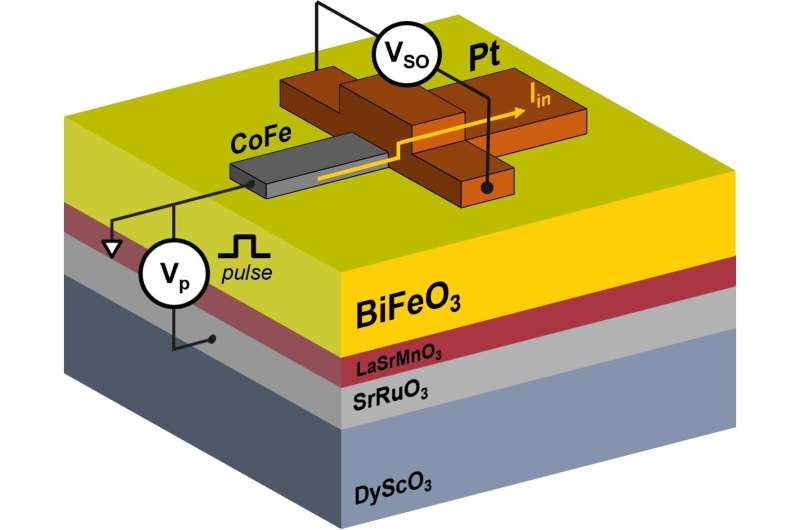This article has been reviewed according to Science X's editorial process and policies. Editors have highlighted the following attributes while ensuring the content's credibility:
fact-checked
peer-reviewed publication
trusted source
proofread
Building block for magnetoelectric spin-orbit logic opens new avenue for low-power beyond-CMOS technologies

In an article published in Nature Communications, an international team led by researchers from the Nanodevices group at CIC nanoGUNE succeeded in voltage-based magnetization switching and reading of magnetoelectric spin-orbit nanodevices. This study constitutes a proof of principle of these nanodevices, which are the building blocks for magnetoelectric spin-orbit (MESO) logic, opening a new avenue for low-power beyond-CMOS technologies.
A pathway for magnetic-field-free, voltage-based switching of magnetism has been proposed using magnetoelectric materials that exhibit more than one of the primary ferroic properties in the same phase. Among several possible combinations, the coexistence of ferroelectricity and ferromagnetism is expected to allow the control of magnetization through switching of the ferroelectric polarization with an electric field.
In this category, bismuth ferrite (BiFeO3) has been the most studied material, exhibiting a tight coupling between antiferromagnetic and ferroelectric orders at room temperature.
The road to multiferroic-based devices has been long and tortuous, with sparse results reported. Yet, it is expected that such devices can bring magnetization writing energies down to the attojoule range, an improvement of several orders of magnitude when compared with state-of-the-art current-based devices.
This driving force led to the recent proposal of MESO logic, suggesting a spin-based nanodevice adjacent to a multiferroic, where the magnetization is switched solely with a voltage pulse and is electrically read using spin-to-charge current conversion (SCC) phenomena.
Now, a team of researchers demonstrated the experimental implementation of such a device. The team fabricated SCC nanodevices on BiFeO3 and analyzed the reversibility of the magnetization of ferromagnetic CoFe using a combination of piezoresponse and magnetic force microscopy, where the polarization state of the BiFeO3 and the magnetization of CoFe are imaged upon switching.
The researchers then correlated this with all-electrical SCC experiments where voltage pulses were applied to switch the BiFeO3, reversing the magnetization of CoFe (writing) and different SCC output voltages were measured depending on the magnetization direction (reading).
The published results support voltage-based magnetization switching and reading in nanodevices at room temperature, enabled by exchange coupling between multiferroic BiFeO3 and ferromagnetic CoFe, for writing, and SCC between CoFe and Pt, for reading.
While further work is required in terms of controllability and reproducibility of the switching, specifically regarding the ferroelectric and magnetic textures in BiFeO3, these results provide a key step forward toward voltage-control of magnetization in nanoscale magnets, essential for future low-power spin-based logic and memory devices.
More information: Diogo C. Vaz et al, Voltage-based magnetization switching and reading in magnetoelectric spin-orbit nanodevices, Nature Communications (2024). DOI: 10.1038/s41467-024-45868-x
Journal information: Nature Communications
Provided by Elhuyar Fundazioa



















